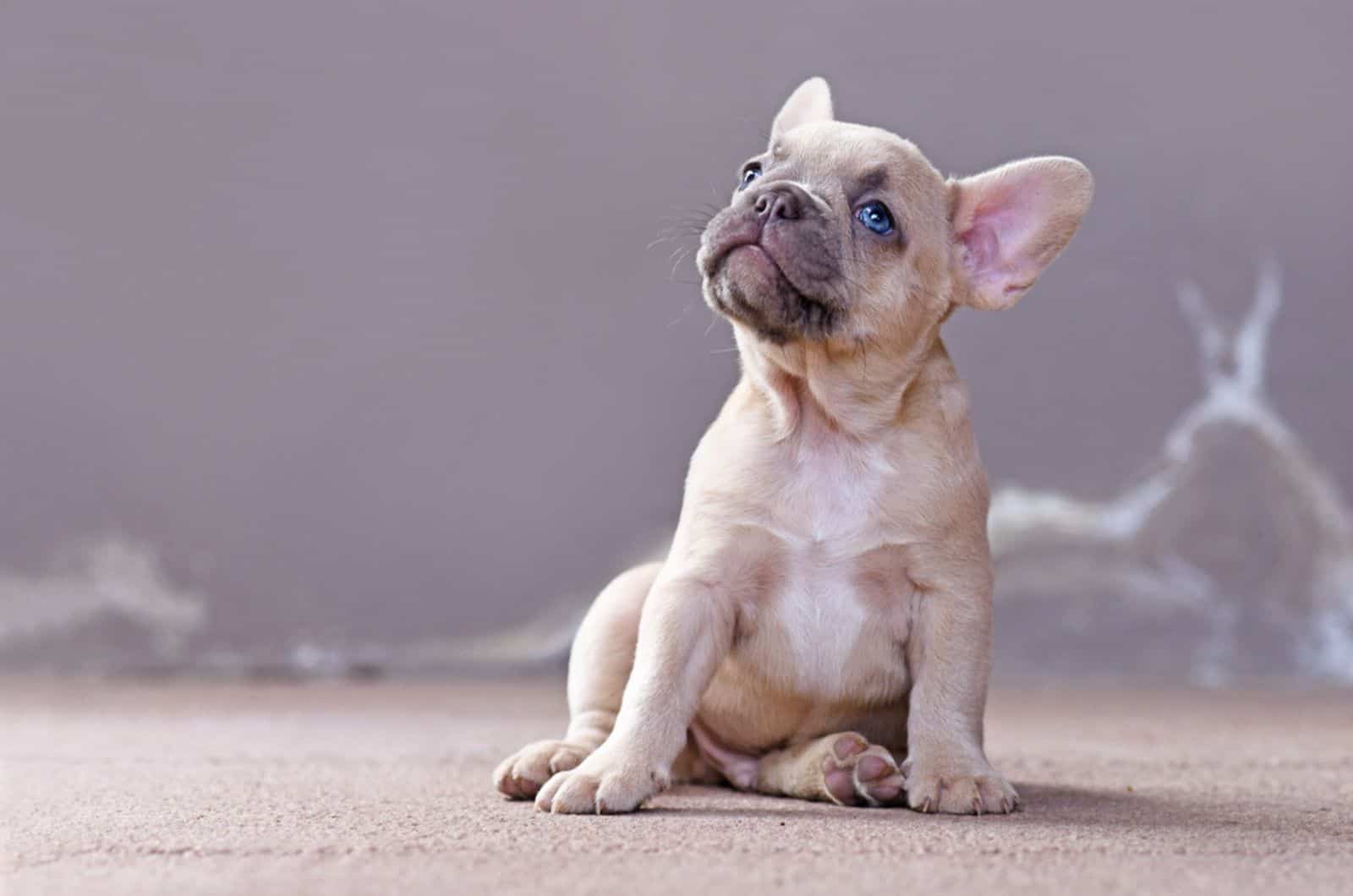Have you heard about the blue-eyed French Bulldog? Even if you have, you probably have a lot of questions about them.
The fact that blue-eyed Frenchies can change their eye color is even more astounding, but what does this mean for the health and well-being of French Bulldogs?
When it comes to the coat color of Frenchies, the AKC accepts numerous hues, but there are also some additional, uncommon hues like blue, lilac, and Isabella.
But it gets even more interesting when we turn to the eye color of these pooches. So let’s learn more about French bulldogs’ renowned blue eyes.
This handy and interesting guide will tell you everything there is to know about blue-eyed French Bulldogs and how they differ from other breeds in more ways than one.
About Blue-Eyed French Bulldogs
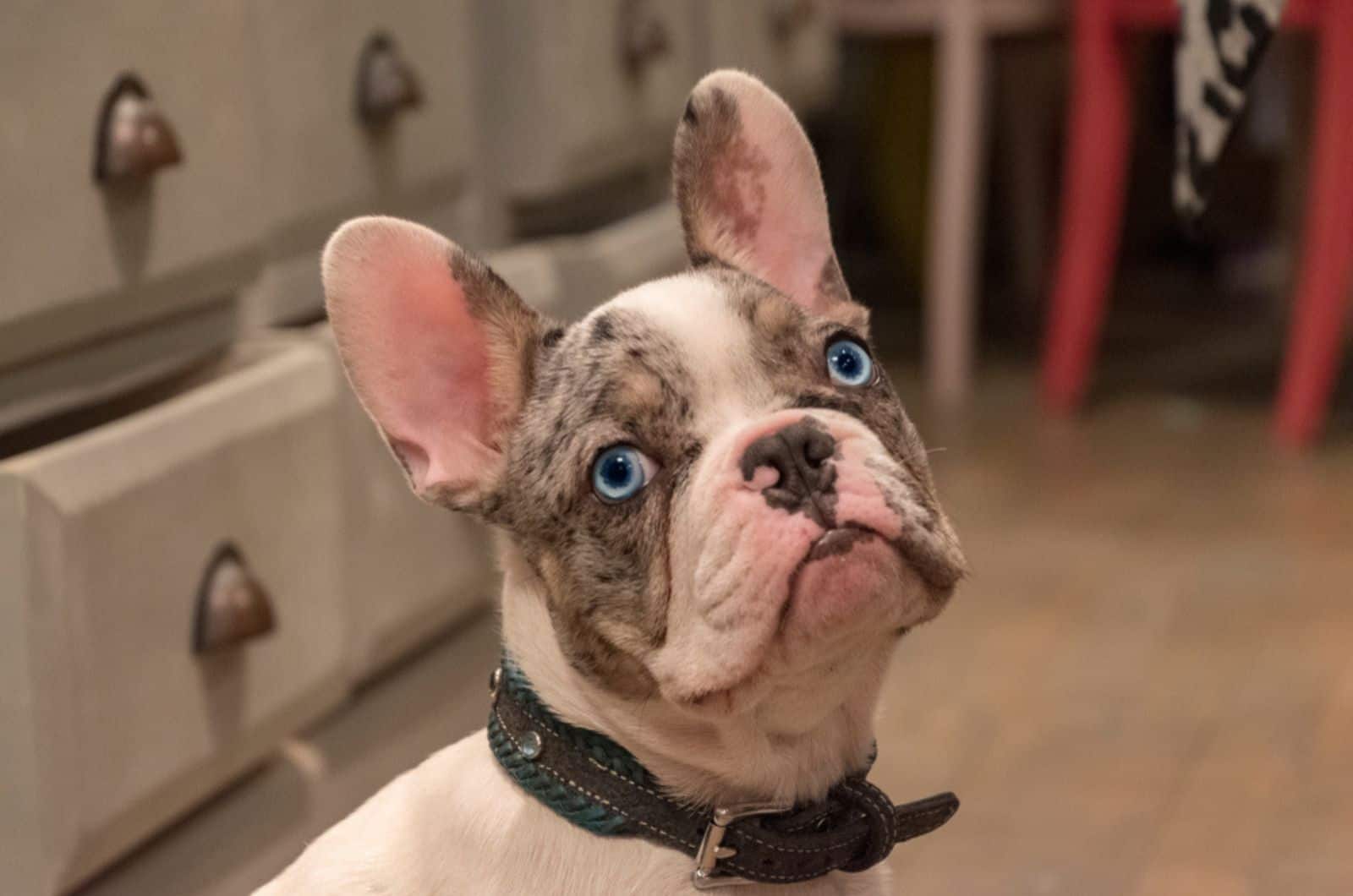
In order to properly start talking about blue-eyed French Bulldogs, we first have to talk about the French Bulldog breed in general.
Around the 1850s, a small Bulldog was developed in England that later became the French Bulldog breed.
Workers in the industrial sector started to migrate to France at the height of the Industrial Revolution. Naturally, they brought their French Bulldogs along, giving rise to the nickname Frenchie for the breed.
These early French Bulldogs did not resemble modern French Bulldogs as much as you might think.
Breeders started breeding these dogs with other breeds, such as Terriers and Pugs, as their fame spread around France, and along the process, they developed their now-famous bat ears.
The American Kennel Club (AKC) first recognized the breed in 1898 as it gained popularity over time, despite its high cost.
Now that we have covered the basic history of the French Bulldog breed, we can move on to talking about the blue-eyed Frenchies in particular.
Are French Bulldogs With Blue Eyes Rare?
Due to the genes that make them up, French Bulldogs with blue eyes are rare but not impossible to find.
The S-locus and M-locus genes cause blue French bulldogs to have a wide range of eye hues, so it’s tough to predict what color eyes puppies will have, even within a single litter.
One thing breeders can do to try to maximize their chances of getting a blue-eyed Frenchie puppy is mating Frenchie parents that have blue eyes themselves.
In short, among the multiple different colors that Frenchie’s eyes can have, blue is one of the rarest ones.
Are Their Eyes Really Blue?
Well, yes and no. Let’s put it this way: they’re as blue as the sky or as the ocean.
But if we’re being petty, the blue in your French Bulldog’s eyes isn’t actually blue. It might sound confusing at first, but there is a perfectly reasonable explanation behind it.
In reality, Frenchies and other blue-eyed dogs don’t have blue eyes at all.
The iris of a dog with blue eyes is entirely colorless and devoid of any pigment. The same process that gives water and the sky their blue color also gives blue eyes their color.
As a result, the dog’s eyes seem blue because all of the light that enters them is scattered back into the surrounding space.
Dogs with blue eyes have an ALX4 gene mutation, which appears to reduce the amount of pigment produced in the eye. The eye appears blue because it lacks pigment.
Blue-Eyed French Bulldog Appearance
Given their muscular and stocky appearance, French Bulldogs typically look like smaller versions of Bulldogs. Frenchies look intelligent and vivacious, have sleek coats, and have a medium or small frame.
Their average size is between 11 to 13 inches tall and weigh between 20 and 28 pounds. The breed, one of the most popular small dog breeds in the world, is distinguished by its pronounced “bat ears.”
Blue Eye Glow In French Bulldogs
Owners of French Bulldogs occasionally may observe a spooky blue eye glow in their pets when the lights are low.
The tapetum lucidum, a light-reflecting surface located between the optic nerve and the retina, is what causes the French Bulldog Blue Eye glow. It functions like a mirror, reflecting light into the eyes so they can see clearly in the dark.
Does Eye Color Have Anything To Do With Coat Color?
Patterns of unpigmented spots on a dog’s coat are brought on by the Piebald gene. Incidentally, this absence of pigmentation is also a contributing factor in dogs’ blue eyes.
Blue-eyed French Bulldogs most commonly have the following coat colors: white, black, grey, fawn, and blue.
These are all relatively rare colors, but Blue Frenchie and Fawn French are somewhat more common.
Why French Bulldogs Have Blue Eyes
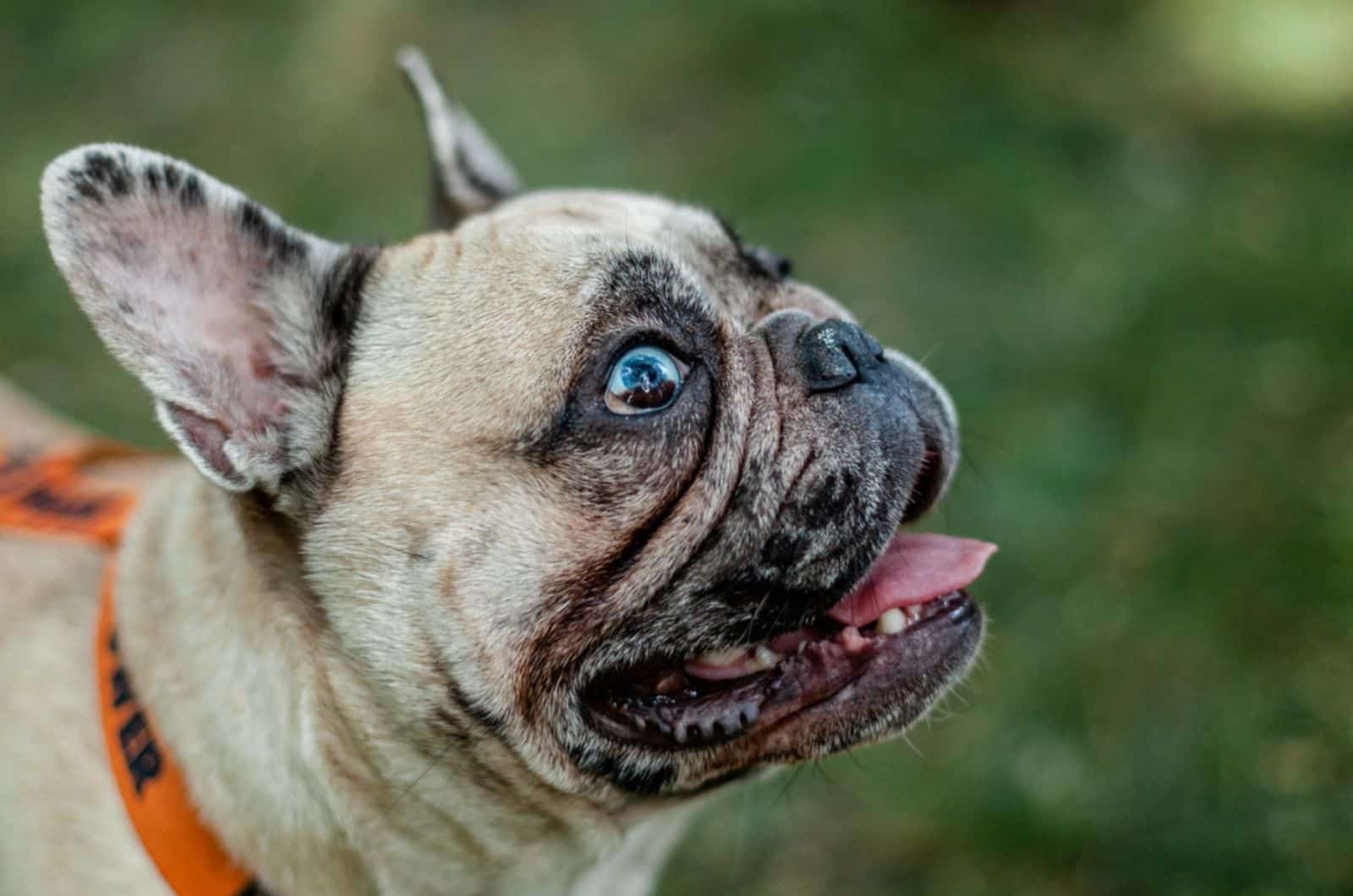
Most dogs have brown eyes, so it’s always interesting to see a dog with a different color, especially if it’s as attractive as light blue. But what causes it in Frenchies?
Your Frenchie’s eye colors may change due to genetics, pigmentation, and health problems. However, the main reason you’ll occasionally get a blue-eyed French Bulldog is genetics.
A Frenchie is more likely to get blue eyes if they have a lengthy history of having them, i.e. if some of its ancestors have had blue eyes.
That’s why your best bet for finding out if your French Bulldog puppy will have blue eyes is to talk to the breeder that sold you the puppy and ask them questions about its parents, grandparents, etc.
But let us now talk about the three most common causes of blue-eyed French Bulldogs, which are the merle gene, the ALX4 gene, and melanin levels in the pup.
Melanin Levels
The amount of melanin in a dog’s body may affect the color of its eyes. If you’re wondering what it actually is, melanin is a pigment that is located in the iris.
Dogs with brown eyes typically have higher levels of melanin in their iris. On the other hand, your dog’s eyes will be lighter the lower the melanin content.
So how can a French Bulldog with lost pigmentation (or melanin) grow blue eyes?
The gene which alters eumelanin, i.e. the dark pigment in melanin, is called the M locus gene. Due to this genetic alteration, some pigmentation in the eye is lost, resulting in the pale brown to blue eye tints seen in some French Bulldogs.
The Merle Gene
As we said, a French Bulldog is more likely to have blue eyes if they carry the M locus gene, which is also sometimes known as the merle gene.
Random pigment dilution or lightening of the color of the nose, eyes, and hair is caused by this gene.
However, some dogs, including French Bulldogs, can carry this gene and still not exhibit any visible physical characteristics associated with it. That means that your Frenchie can have the merle gene in its DNA but still have those traditional brown eyes.
The ALX4 Gene
A recent study by Embark Veterinary, which is one of the leading dog DNA testing firms out there, examined the complete genetic profiles of 6,000 dogs and discovered a high association between blue eyes in dogs and a genetic mutation located close to the ALX4 gene.
Without this genetic alteration, brown eyes are more likely to develop in French Bulldogs.
In the simplest of terms, if your Frenchie has this genetic mutation, it is highly likely that it will have noticeably blue eyes.
Blue-Eyed French Bulldog Personality And Temperament
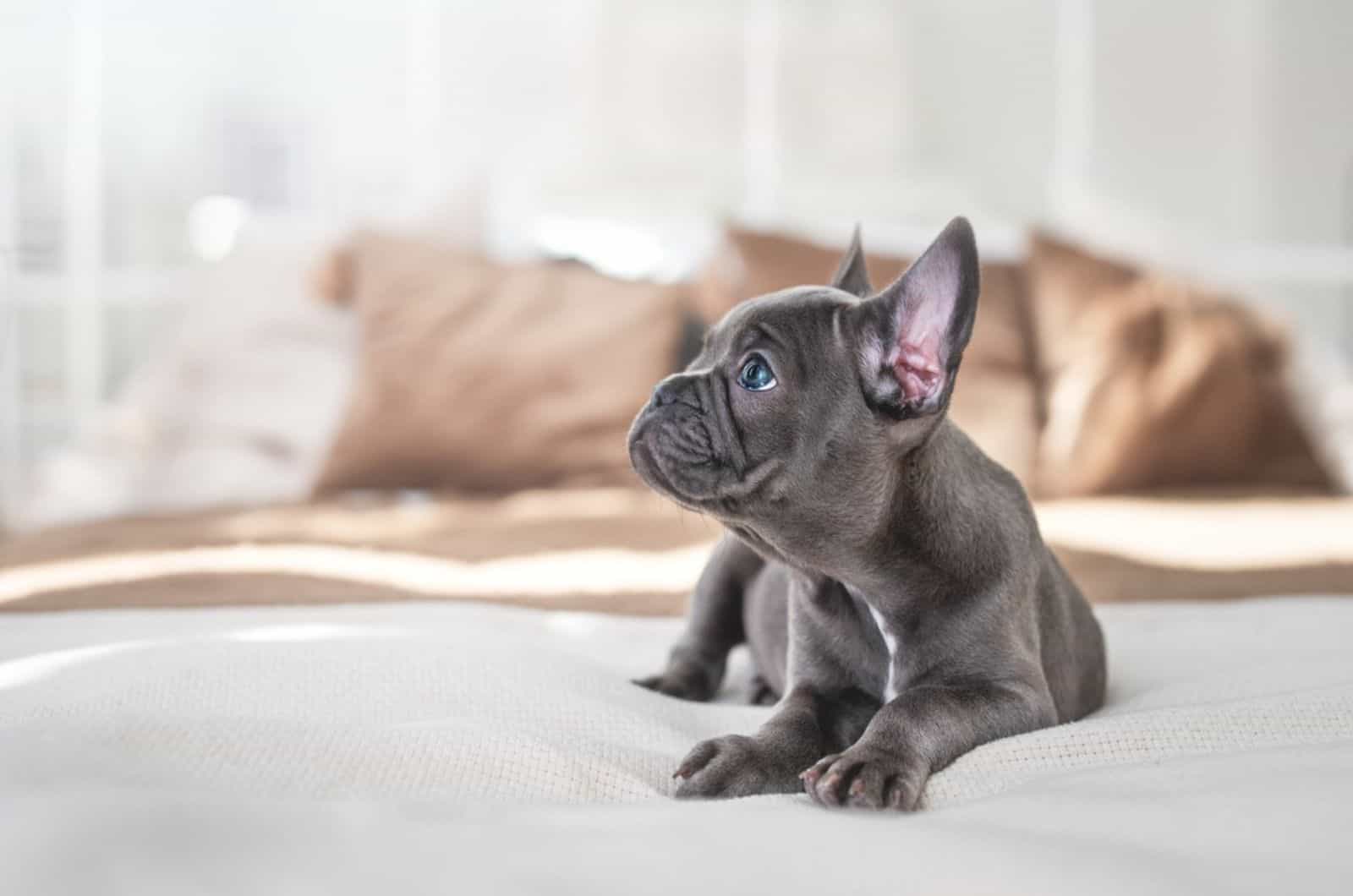
What can you expect from the blue-eyed French Bulldog in terms of personality, temperament, and behavior, we hear you ask.
The American Kennel Club describes the Frenchie as intelligent, playful, attentive, and joyous. Generally speaking, they are calm, but they need your attention.
Although they don’t typically bark, they will when they become excited. Another distinguishing trait of this breed is that they frequently snort.
Frenchies are small, but good watchdogs because they are constantly vigilant and aware of their surroundings. Frenchies make friendly, affectionate, but not overly loud, friends.
Those are all traits and characteristics that describe a typical French Bulldog, and the ones with blue eyes are no exception.
Of course, there will be slight but distinct variations with each individual dog, but at the end of the day, there are some commonalities that you can use as your guide.
Health Issues And Risks In Blue-Eyed Frenchies
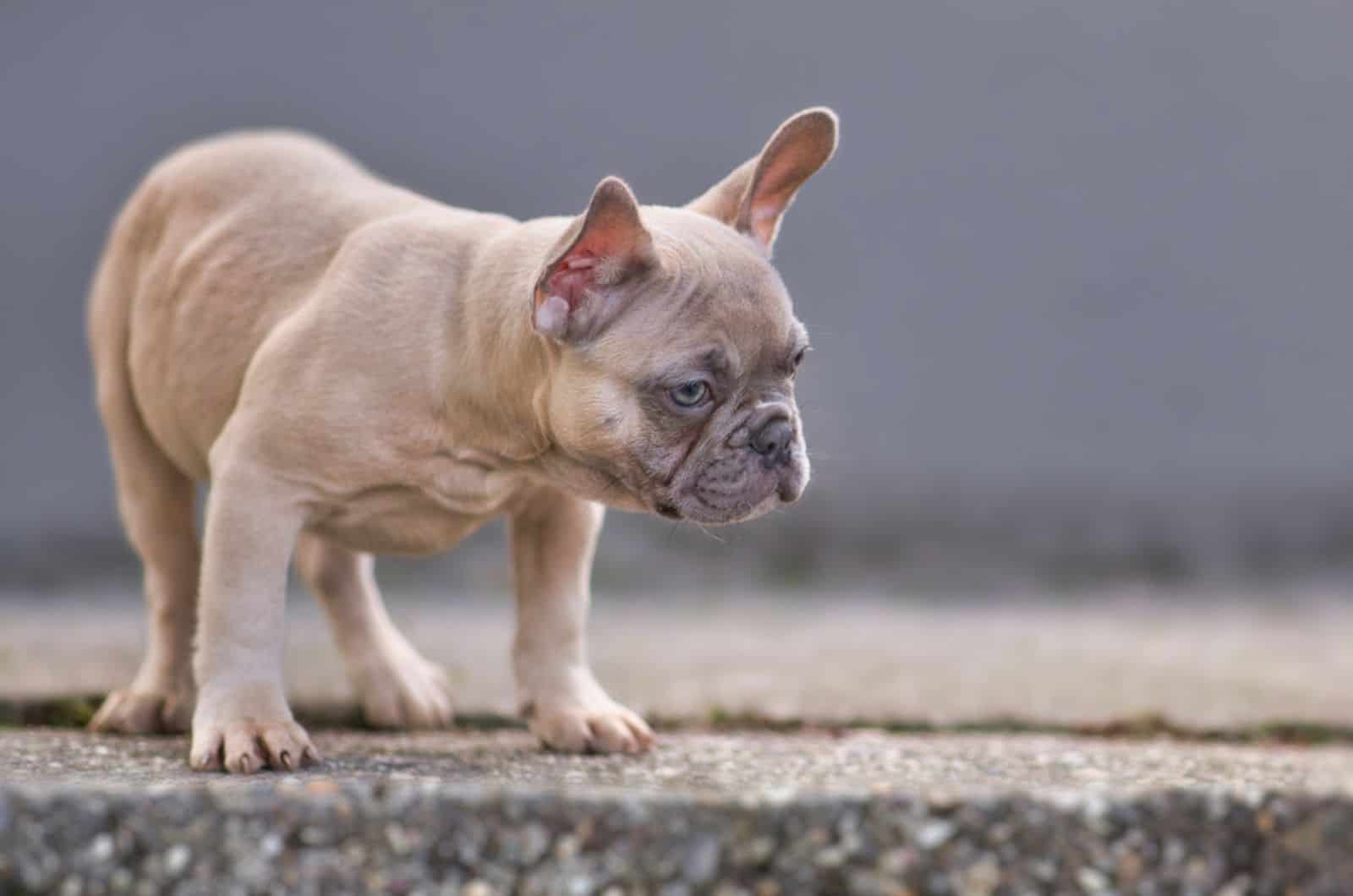
Despite having strikingly attractive blue eyes, these types of French Bulldogs are more likely to experience serious health issues than Frenchies with brown eyes.
This breed is prone to a wide range of health issues. To find out what other health issues this breed faces, you should probably consult your veterinarian and have a chant about your blue-eyed Frenchie.
However, before you do that, reading this article will give you a good overview of some of those health risks, so that you can know what you’re getting yourself into.
Blindness
French Bulldogs with blue eyes may be at a higher risk for eyesight problems than their brown-eyed counterparts.
Experts suspect that this might be related to the merle genes that can be detected in a Frenchie with blue eyes. Incidentally, that is considered to be a dominant gene.
This does not necessarily imply that a merle French Bulldog will eventually lose its eyesight, though. It just means that a Frenchie puppy is more likely to develop eye defects like blindness if both parents have the merle gene.
Deafness
French Bulldogs with blue eyes frequently have hearing loss or deafness, which is something that can be detected by using a so-called BAER test.
Certain dog breeds that carry the Merle and Piebald genes have this health condition. The Merle gene is associated with congenital deafness, whereas the Piebald gene is in charge of dogs’ spotted or multicolored coats.
Due to a shortage of mature melanocytes (cells that produce melanin) in the inner ear, it is well known that the Piebald gene can also result in deafness.
Skin Allergies
Skin allergies and autoimmune conditions of the skin are also widespread in Frenchies.
Blue-eyed French bulldogs are more likely to experience allergies and skin issues in general. They frequently have pale pink skin around their mouth and eyes. Our recommendation is to apply sunscreen to protect them.
Cherry Eye
The most common ailment that causes red eyes in French Bulldogs is the so-called cherry eye, i.e. prolapse of the third eyelid gland.
As a result, the eyes become dry, bloodshot, and red. Visit your veterinarian if you notice this. It could also be a sign of corneal ulcers or dry eye syndrome.
Other Eye Issues
Apart from the issues that we have already listed, there are others that are perhaps not as common, but you should still at least know about them.
This way, you will be better prepared for taking care of your blue-eyed French Bulldog and making sure it stays in optimal health for as long as possible.
One of the issues, which can run in families, is corneal dystrophy. As a result, the French Bulldog’s color will shift to a dull blue appearance, indicating that it has eyesight problems.
Dogs older than 5 years old are more likely to get nuclear sclerosis. Your dog may not feel any pain, but it could affect his vision. Our recommendation is to speak with a veterinarian right away.
Heterochromia may also be a problem for French Bulldogs. Heterochromia comes in two varieties: congenital and acquired.
Breeds of dogs most prone to developing nasal hyperkeratosis, or the thickening and hardening of the skin on the nose, include French Bulldogs.
And finally, a few more vision defects that can occasionally crop up in blue-eyed French Bulldogs are entropion, glaucoma, and juvenile cataracts.
What Is The Lifespan Of A Blue Eyed French Bulldog
The average lifespan of a French Bulldog is between ten and twelve years.
That same range generally applies to the blue-eyed Frenchies, as well, but perhaps with an asterisk attached to it.
Since blue-eyed French Bulldogs are at a higher risk of developing or being born with a number of different medical conditions, chances are that a lot of them will sadly not live into their old age.
What Are Some Other Eye Colors In French Bulldogs?
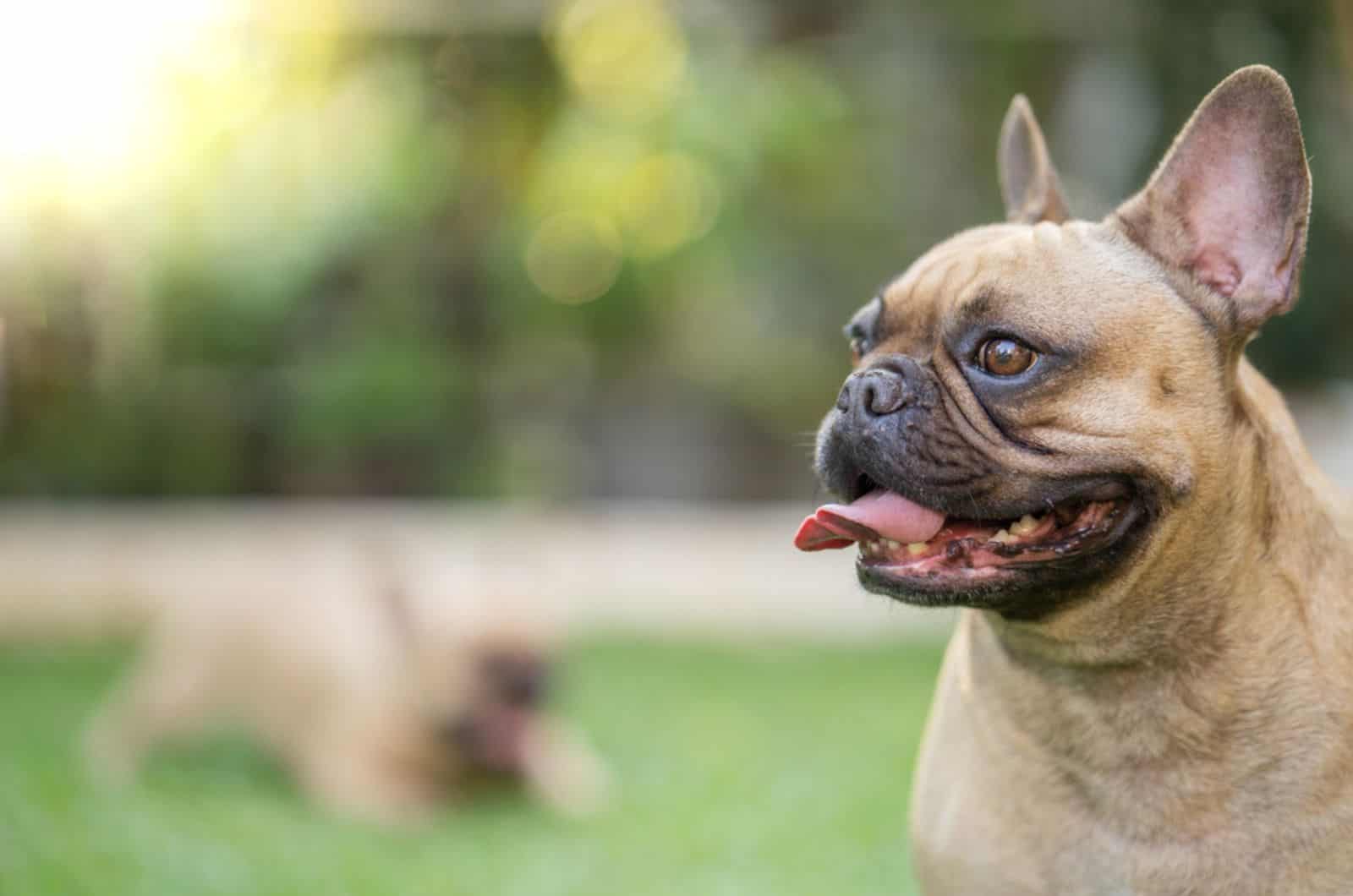
The French Bulldog breed standard published by the AKC specifies that the breed’s eyes should be moderately sized, round in shape, and free from bulging or depressed areas.
The eyes of a French Bulldog should be widely spaced, low in the skull, and as far away from the ear as feasible.
But what shades do French Bulldogs have in their eyes?
The most typical eye color for Frenchies is brown eyes, which are found in most French Bulldogs out there.
Due to high melanin levels and perhaps a lack of the merle gene, they have brown eyes, but they can occasionally appear to look light hazel or even close to green.
The AKC breed standard prefers French Bulldogs with eyes that are black or nearly black in hue. Black-eyed dogs have an even higher melanin level than brown-eyed ones which is why their eyes get so dark.
Other, less typical French Bulldog eye colors are grey, green, and, of course, the previously mentioned blue.
Blue Eyed Frenchies Vs. Brown Eyed Frenchies
The biggest physical difference between the two variants is, of course, the color of their eyes. However, other than that there isn’t much to tell them apart, aside from the slight correlation between eye color and coat color that we’ve already discussed.
Given their stocky and powerful build, French Bulldogs generally resemble Bulldogs in miniature. Frenchies have smooth coats, and a medium or petite body size, and they appear intelligent and lively.
Males can weigh between 20 and 28 pounds and grow to reach 11 to 13 inches tall. Frenchies that are female are almost the same size. One of the most well-known little dog breeds in the world, the breed is known for its very prominent “bat ears.”
Blue-Eyed French Bulldog FAQ
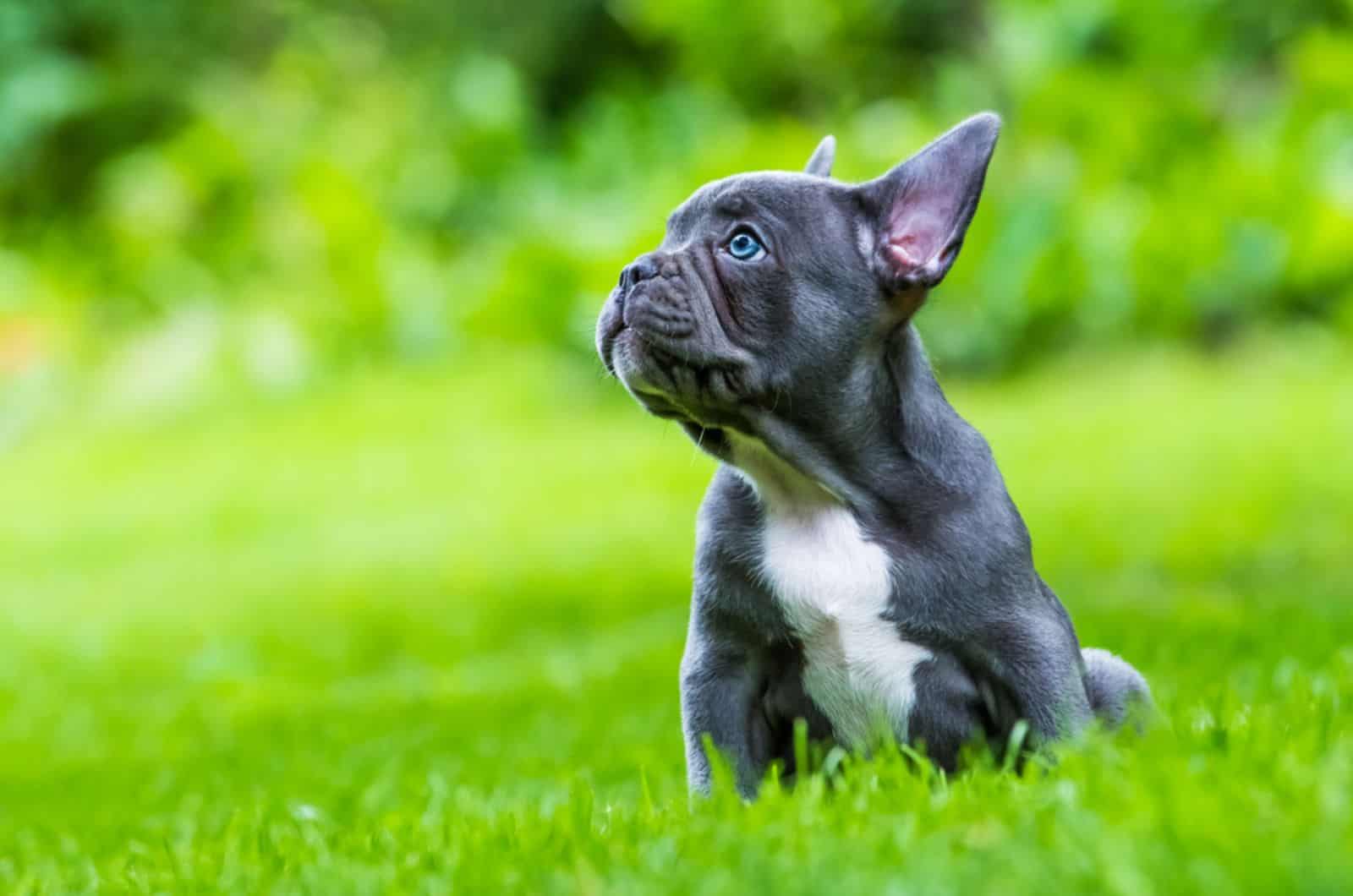
Blue-eyed French Bulldogs are a truly wonderful and fascinating breed of dog, and we are sure you think so too, especially after reading the article so far.
However, there are many things that can be learned about them, some of them bad and some of them good. While we have covered a lot of those things in the preceding sections of this post, there are some questions that we have left unanswered.
With that in mind, we’ve decided to make this the part of the post in which we will discuss the most frequently asked questions about the blue-eyed French Bulldogs that we could find on the world wide web.
So, if you’re one of the people that were asking these questions, whether just in your mind or actually typing them out online, this is where you finally get your answers.
You might be surprised, but most dogs, regardless of breed or color, are born with blue eyes. They remain blue for a few weeks because melanin production has not yet begun.
Your Frenchie’s eyes typically change to their permanent color a few weeks later.
Usually, it takes nine to twelve weeks for a puppy’s eye color to take on its final shape after birth. The eyes might undergo irreversible alteration even at the advanced age of 16 weeks.
The majority of dogs, including Frenchies, end up having dark brown eyes.
Do the eyes of French Bulldogs ever change their color?
All puppies are born with blue eyes, and, due to the fact that melanin formation in the eyes does not start until the pups are a few weeks old, their eyes seem blue up until this time.
Blue-eyed French Bulldogs are remarkable creatures, to say the least, but do the eyes stay blue as they age? Actually, not for long! At least, that’s the case with most Frenchies.
Several weeks later, your Frenchie’s eyes normally transition to their permanent hue. A puppy’s eye color typically takes nine to twelve weeks after birth to settle into its final form. Even at the late age of 16 weeks, the eyes can change permanently.
No, blue-eyed French Bulldogs are not color blind, but they can only see certain colors, like blue, yellow, and various shades of gray, just like the majority of dog breeds.
This is due to the fact that, in contrast to humans, who have red, blue, and yellow color cone cells, animals only have two color cone cells in the retina — yellow and blue.
Frenchies are typically wonderful family dogs or companions for solitary dog owners.
The French Bulldog is a great breed if you enjoy cuddling with dogs and find pushed-in faces attractive.
Frenchies get along with other animals well and quickly adjust to new circumstances. They don’t need a lot of outdoor exercise, so if you like to take your pets for runs and are an active person, you might want to think about getting a different breed.
Although they can be difficult to teach, they generally want to please their owners, according to the AKC. Be aware that Frenchies may need extra attention because they are a breed with a flat face that is prone to breathing problems.
The health issues we discussed in this article are among their biggest drawbacks.
Due to their lack of aggression and their stellar reputation as acceptable family dogs for children, blue-eyed Frenchies do really make wonderful household pets. This dog will get along just great with other home pets as well.
However, you need to take good care of them if you want them to be happy. A big part of that is grooming.
To prevent shedding, you have to routinely brush the Frenchie’s coat. Frenchies shed more throughout the spring and fall seasons, and this is the time when we recommend using a more powerful de-shedding tool.
French Bulldogs with blue eyes are fairly uncommon but they are not impossible to find. This is due to the specific set of genes that make them up.
Even within a single litter, the hue of a puppy’s eyes is difficult to anticipate, so you can very rarely be certain that you will get a blue-eyed French Bulldog.
Even if you go as far as making sure to always mate two blue-eyed parent dogs, you can’t be guaranteed that their puppies will be the same.
French Bulldog litters typically have three or four puppies in them, so it’s a long shot.
In summary, blue is one of the rarest eye colors among the many that Frenchie’s eyes can have.
Purchasing a French Bulldog can be rather expensive, whatever the color of its eyes might be. You should budget somewhere between $1,800 and $4,500 for the puppy if you plan to get it from a reputable breeder.
This puts the average cost at about $2,800.
A French Bulldog, however, can cost significantly more, depending on a number of criteria. Some of the most well-known breeders command prices as high as $20,000 when selling their dogs!
As you can see, French Bulldog prices vary widely. There are some variables that can cause the price to dramatically increase or decrease.
The price is also influenced by the dog’s bloodline and the reputation of the breeder. Breeders of show dogs typically invest a lot of money in their pups, so it only makes sense that they would sell them for a much greater price.
As with most dog breeds, your best bet is to look for specialized reputable breeders in your area.
However, that is particularly true in the case of French Bulldogs, and even more so when it comes to blue-eyed Frenchies!
Breeding French Bulldogs is not a simple task. The majority of females need a c-section and artificial insemination to have healthy puppies.
These canines’ small and slender hips, however, prevent the majority of males from mounting females. Natural reproduction is therefore impossible.
Since Frenchies cannot naturally reproduce, breeders must work harder and spend more money mating them. This implies that the cost will also increase.
However, all that doesn’t mean that it’s impossible. In fact, there are many respected, reliable, and reputable French Bulldog breeders available, and some of them are bound to have the blue-eyed version in their ranks.
Some people believe that breeding two blue-eyed dogs is unethical and cruel. Why is that?
Well, the term double merle is used to describe the offspring of two Merle gene carriers. As we previously mentioned, this increases the little’s likelihood of developing health problems.
However, there is a larger chance of getting puppies with congenital health problems including deafness or blindness when breeding blue-eyed French bulldogs. When a Marle carrier breeds with a non-carrier, the likelihood of any health problems in the offspring is decreased.
Make sure the male and female French Bulldogs are from sound genetics before breeding them. Breeding Frenchies with blue eyes is the same as breeding Frenchies without blue eyes.
Wait until the female has had her second heat cycle and is at least two years old. Female Frenchies should not be bred during two consecutive heat seasons. She requires adequate recovery time.
The average French Bulldog litter size is said to be between three and four puppies, with seven being the absolute maximum.
Blue eyes and gender are not correlated in a clear way. The merle gene is the primary cause of certain Frenchies having blue eyes, and the likelihood that this will happen in males and females is nearly equal.
However, there are some other differences between the two genders of the French Bulldog breed in general. You can find out more about that in this comparison article.
While brown and black are the most prevalent eye colors in the canine world, there are dogs that stand out with a pair of light blue ones.
A recessive gene causes blue eyes in several dog breeds, which we generally associate with having cool blue eyes naturally.
Dogs with coats that have merle (mottled markings) or piebald patterns (a white coat with points) frequently have blue eyes. As a result, if your dog carries the piebald or merle gene, it is unable to produce pigment, which causes blue eyes to develop.
In the same way, albino canines lack melanin pigmentation and frequently have blue eyes.
Aside from the previously mentioned Siberian Husky, there are several other dog breeds that can develop blue eyes. Some of them are Dalmatians, Great Danes, and Border Collies, as well as Pitbulls, Boxers, Poodles, and others.
If you want more details, we have an exhaustive list of 36 beautiful blue-eyed dog breeds here.
Conclusion
Blue-eyed French Bulldogs are extremely special and adorable!
Their attractiveness is what draws attention to them, but it’s also their amusing personality that makes people fall in love with them.
They are the ideal pet for city dwellers and do well in cramped quarters. Perhaps this is another factor in the popularity of this adorable little puppy.
However, they are not without controversy, and it would be remiss of us not to mention their many health risks that make many people call breeding them unethical.
If you decide to get a French Bulldog, be prepared to invest a significant amount of time and money, as well as extra care if you wish to keep it happy.
Prior to purchasing a Frenchie, do extensive research on reliable local breeders as well as cost-effective veterinary hospitals.
In comparison to other breeds, owning a blue-eyed French Bulldog can be fairly pricey.
Read Next: Blue Fawn French Bulldog Color Analysis
